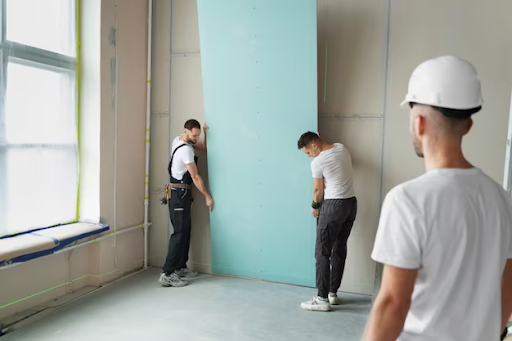Though asbestos was highly regarded for its ability to withstand fire and endure, it’s now recognized as a culprit of health hazards. Consequently, strict regulations have been set in place regarding the handling of suspected wall sheeting that contains this material. This article aims to equip you with vital knowledge and safety measures required when dealing with any such materials. It’s crucial to understand how critical identifying potential asbestos-containing sheets are; taking necessary precautions could be lifesaving!
Understanding Asbestos and Its Use in Wall Sheeting

Alt: Wall Installing
Asbestos, a group of six naturally occurring fibrous minerals, has a long history of use in construction materials, including wall sheeting. Asbestos is known for its unique properties, which made it a popular choice in various industries, including construction. These properties include:
- Heat Resistance: Asbestos can withstand high temperatures without melting or breaking down, making it ideal for fire-resistant applications. Its ability to resist heat made it a valuable component in materials used in environments with high-temperature fluctuations.
- Electrical Resistance: Asbestos has excellent electrical insulating properties, which contributed to its use in electrical applications. Its capacity to insulate against electrical currents safely led to its integration into electrical insulation materials, ensuring safety and functionality.
- Corrosion Resistance: Asbestos is highly resistant to chemical corrosion, adding to its durability as a construction material. This property allowed asbestos-containing materials to withstand exposure to various chemicals, extending their longevity.
- Durability: Asbestos materials have a long lifespan, which made them attractive for use in buildings and infrastructure. This durability factor, coupled with other properties, contributed to asbestos becoming a preferred choice for constructing walls, roofs, and other structural components.
However, despite these advantageous qualities, the use of asbestos has significantly declined in recent decades due to the well-documented health risks associated with asbestos exposure. Prolonged inhalation of asbestos fibers can lead to severe health problems, including lung cancer, asbestosis, and mesothelioma. These risks have led to strict regulations governing the handling, removal, and disposal of asbestos-containing materials.
How to Identify Asbestos Wall Sheeting
Identifying asbestos wall sheeting is crucial for ensuring safety. While professional inspection is always recommended, here are some tips on how to identify asbestos wall sheeting:
Age of Building
One of the primary indicators of the presence of asbestos in wall sheeting is the age of the building. Asbestos was commonly used in construction materials from the 1940s to the 1990s. If your building falls within this time frame, there’s a higher likelihood of asbestos-containing materials, including wall sheeting.
Visual Inspection
Visual inspection is an essential step in identifying asbestos wall sheeting. While not definitive, certain visual characteristics can suggest the presence of asbestos. Pay attention to the following:
| Visual Characteristics | Description |
| Dimpled or Stippled Pattern | Asbestos wall sheeting often exhibits a textured surface with a dimpled or stippled pattern. This texture is distinctive and can raise suspicion of asbestos content. |
| Color and Appearance | Asbestos sheets may have a grayish or off-white color. However, color alone is not a definitive indicator, as other non-asbestos materials can have similar colors. |
| Thickness and Durability | Asbestos sheets tend to be thicker and more durable than non-asbestos alternatives. They may also have a chalky appearance on the backside. |
| Presence of Visible Fibers | Inspect the sheeting for visible asbestos fibers protruding from the surface. This is a strong indicator of asbestos content. |
Labeling
In some cases, older asbestos-containing materials may bear labels or markings that indicate their asbestos content. However, reliance solely on labels is not recommended, as labels may have deteriorated or been removed over time. Labels can provide valuable information but should not be the sole basis for identification.
Professional Testing
For the most accurate and reliable identification of asbestos wall sheeting, it is strongly advised to engage professional asbestos inspectors or consultants. They can conduct a thorough inspection and, if necessary, perform professional sampling. The steps involved in professional testing typically include:
- Site Assessment: Inspectors will assess the building and its history to identify potential asbestos-containing materials.
- Sample Collection: Small samples of suspected materials will be collected with minimal disturbance to the area.
- Laboratory Analysis: Collected samples are sent to accredited laboratories for in-depth analysis. Microscopic examination and testing confirm the presence of asbestos fibers.
- Report and Recommendations: Once the laboratory results are obtained, inspectors provide a detailed report and recommendations for safe handling or removal if necessary.
Professional testing is the most reliable method to definitively identify asbestos wall sheeting and ensure safety compliance.
Safety Precautions When Handling Asbestos Wall Sheeting

Handling asbestos wall sheeting requires strict adherence to safety precautions to protect the health of individuals involved in the process. Asbestos, a hazardous material, poses significant health risks when its fibers are released into the air. Let’s delve into the detailed safety precautions that must be followed when handling asbestos-containing wall sheeting. These precautions are crucial to minimize exposure to asbestos and ensure a safe working environment.
Avoid Disturbing the Material
The cardinal rule when dealing with asbestos-containing materials is to avoid disturbing the material unless absolutely necessary. Disturbing asbestos wall sheeting can release asbestos fibers into the air, posing a significant health risk. Here are some in-depth considerations:
- Visual Inspection: Conduct a thorough visual inspection of the work area and materials before any tasks begin. If you suspect material contains asbestos, take extra precautions.
- Minimize Activity: If you come across asbestos wall sheeting, leave it undisturbed whenever possible. Avoid sanding, scraping, drilling, or any activity that might release fibers.
- Professional Assessment: Consider hiring a certified asbestos professional to evaluate the situation and provide guidance on safe management if asbestos-containing materials are present.
Wear Protective Gear
Personal protective equipment (PPE) is a fundamental aspect of asbestos safety. Properly selected and worn PPE helps to minimize the risk of asbestos exposure. The following PPE should be utilized:
- Respirator with a HEPA Filter: A respirator equipped with a High-Efficiency Particulate Air (HEPA) filter is essential to filter out asbestos fibers from the air you breathe. Fit testing and proper seal are crucial.
- Gloves: Wear disposable gloves made of nitrile or latex to protect your hands from direct contact with asbestos fibers.
- Coveralls: Use disposable coveralls with a hood and shoe covers to prevent asbestos fibers from adhering to your clothing or skin.
- Eye Protection: Safety goggles or a face shield should be worn to shield your eyes from potential asbestos exposure.
- Respirator Maintenance: Ensure that respirators are properly maintained and inspected regularly to guarantee their effectiveness.
Wet Methods
Employing wet methods is vital when cutting, drilling, or conducting any activities that may disturb asbestos wall sheeting. Wetting the material helps to suppress dust and prevents the release of asbestos fibers. Here’s an in-depth look at wet methods:
- Wetting the Material: Before starting any tasks, thoroughly wet the asbestos-containing material using a fine mist of water. This effectively keeps asbestos fibers from becoming airborne.
- Continuous Wetting: Maintain continuous wetting of the material throughout the job to sustain moisture levels and minimize dust generation.
- Use of PPE: Ensure that workers handling wet asbestos materials wear appropriate PPE to protect themselves from potential exposure.
Proper Disposal
The proper disposal of asbestos waste is a critical aspect of asbestos safety to prevent the spread of asbestos fibers and protect the environment. Proper disposal includes the following steps:
- Wetting: Thoroughly wet the asbestos-containing waste to suppress dust and prevent fiber release during handling.
- Bagging: Place the wet asbestos waste in labeled heavy-duty bags designed for asbestos disposal. Double-bagging may be required in some cases.
- Sealing: Seal the bags tightly to prevent any asbestos fibers from escaping.
- Labeling: Clearly mark the bags with asbestos warning labels to indicate their hazardous contents.
- Authorized Waste Disposal: Dispose of the labeled bags at authorized waste disposal sites that are licensed to handle asbestos-containing materials. Ensure compliance with local regulations.
In-Depth Training and Education
In addition to the key safety precautions mentioned above, it is essential that anyone working with asbestos-containing materials undergoes comprehensive training and education. This includes:
- Identification of Asbestos: Understanding how to identify asbestos-containing materials through visual inspection and historical context.
- Safe Work Practices: Training in safe work practices, including the proper use of PPE, wet methods, and disposal procedures.
- Emergency Response: Preparation for handling emergencies or accidental exposure, including knowledge of first aid and decontamination procedures.
Health Risks of Asbestos Exposure
Asbestos exposure is a serious health concern that can have devastating consequences on an individual’s well-being. In this comprehensive guide, we will delve into the various health risks associated with asbestos exposure. Let’s explore three main health conditions linked to asbestos exposure in detail:
Asbestosis
Asbestosis is a severe, chronic lung condition that results from inhaling asbestos fibers. It is characterized by the scarring of lung tissue, leading to breathing difficulties and reduced lung function.
- Causes: Inhalation of asbestos fibers over an extended period, typically due to occupational exposure in industries like construction, shipbuilding, and asbestos mining.
- Symptoms: Symptoms often do not manifest until several years after exposure and may include shortness of breath, persistent cough, chest tightness, and fatigue.
- Diagnosis: Asbestosis is diagnosed through medical history, physical examination, lung function tests, and imaging studies like chest X-rays and CT scans.
- Treatment: There is no cure for asbestosis. Treatment aims to manage symptoms and may include oxygen therapy, pulmonary rehabilitation, and medications to alleviate symptoms.
- Prevention: The best way to prevent asbestosis is to minimize exposure to asbestos by following safety protocols and wearing protective gear in high-risk workplaces.
Lung Cancer
Lung cancer is a malignant tumor that forms in the lungs, often triggered by the inhalation of asbestos fibers. It is one of the most common cancers associated with asbestos exposure.
- Causes: Prolonged exposure to asbestos significantly increases the risk of developing lung cancer, especially in individuals who also smoke.
- Symptoms: Symptoms can be nonspecific and may include persistent cough, chest pain, unexplained weight loss, and coughing up blood.
- Diagnosis: Lung cancer is diagnosed through various tests, including chest X-rays, CT scans, biopsies, and lung function tests.
- Treatment: Treatment options for lung cancer include surgery, chemotherapy, radiation therapy, targeted therapy, and immunotherapy, depending on the stage and type of cancer.
- Prevention: Quitting smoking and minimizing exposure to asbestos are essential preventive measures to reduce the risk of asbestos-related lung cancer.
Mesothelioma
Mesothelioma is a rare and aggressive form of cancer that affects the lining of the lungs, chest cavity (pleura), or abdominal cavity (peritoneum). It is exclusively associated with asbestos exposure.
- Causes: Mesothelioma is primarily caused by inhaling or ingesting asbestos fibers, and it can take several decades for symptoms to develop.
- Symptoms: Symptoms vary depending on the type and stage of mesothelioma but often include chest pain, shortness of breath, cough, abdominal swelling, and weight loss.
- Diagnosis: Diagnosis involves imaging studies like CT scans and MRIs, along with biopsies to confirm the presence of mesothelioma cells.
- Treatment: Treatment options include surgery, chemotherapy, radiation therapy, and emerging therapies like immunotherapy. The stage at diagnosis significantly impacts treatment possibilities.
- Prevention: Preventing mesothelioma relies on minimizing asbestos exposure and adhering to safety guidelines in high-risk occupations.
Conclusion
Understanding how to identify asbestos wall sheeting and taking appropriate safety precautions are critical steps in ensuring the health and safety of everyone involved. Whether you’re a homeowner, a DIY enthusiast, or a construction worker, always err on the side of caution and seek professional advice when dealing with potential asbestos materials. Remember, no job or home improvement is worth risking your health.
While this article provides a good starting point, it’s important to consult with local authorities and professionals for specific guidelines and regulations regarding asbestos in your area. Stay informed, stay cautious, and always prioritize safety when handling any materials that may contain asbestos.
FAQs
Q: Can I remove asbestos wall sheeting myself?
A: It’s strongly recommended that removal of asbestos-containing materials be done by licensed professionals due to the health risks involved.
Q: How do I know if my wall sheeting contains asbestos?
A: Identifying asbestos can be difficult. If the building was constructed or renovated between the 1940s and 1990s, there’s a chance it contains asbestos. A professional test is the most reliable method.
Q: What should I do if I accidentally disturb asbestos wall sheeting?
A: Stop work immediately, isolate the area, and consult with a professional. Do not attempt to clean up or dispose of the material yourself.




